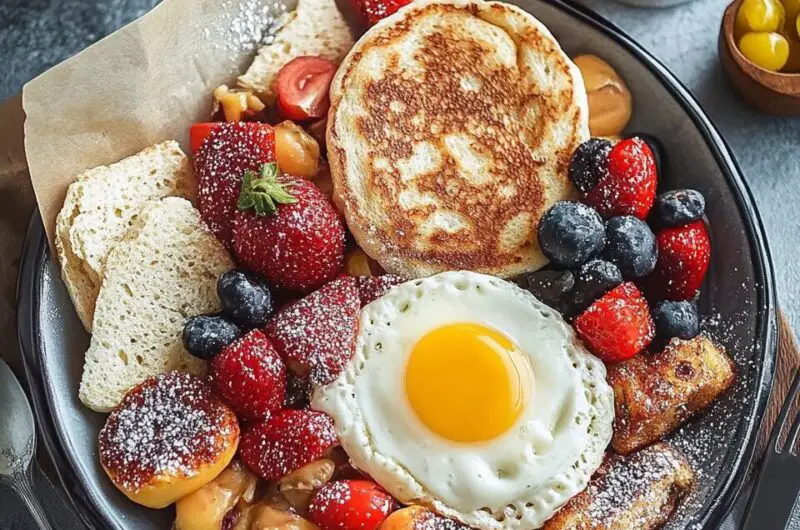A Full Irish Breakfast is a feast meant to keep you going all day! Packed with sausages, crispy bacon rashers, black pudding, fried eggs, tomatoes, and buttery toast, this dish is an essential part of Irish culinary tradition. Whether enjoyed at a cozy B&B in the Irish countryside or made at home for a weekend brunch, this hearty meal is a true comfort food classic. What makes this breakfast special is its combination of textures and flavors from the savory crispiness of the bacon and black pudding to the soft warmth of baked beans and hash browns. Paired with a hot cup of tea or coffee, it’s the perfect way to start your morning on a delicious note.
Full Recipe:
Ingredients:
- 8 pork sausages
- 4 hash browns
- 8 slices of black pudding
- 2 tbsp butter or oil
- 8 bacon rashers (back bacon preferred)
- 8 mushrooms, cleaned and quartered
- 1 large tomato, quartered
- 4 eggs
- 1 can (14 oz / 400g) baked beans
- Toasted Irish soda bread or brown bread, for serving
- Tea or coffee, for serving
Directions:
- Preheat the oven to 400°F (200°C).
- Arrange the sausages, hash browns, and black pudding slices on a baking tray lined with parchment paper. Bake for 15-20 minutes, turning halfway through.
- Meanwhile, heat a large skillet over medium heat with butter or oil. Fry the bacon rashers until golden and cooked through. Remove and keep warm.
- In the same pan, fry the mushrooms and tomatoes for 3-4 minutes until softened. Transfer to a plate and keep warm.
- Wipe the skillet clean, add a bit more oil if needed, and fry the eggs to your liking.
- Heat the baked beans in a small saucepan or microwave.
- Serve everything together on a plate with toasted Irish soda bread and a hot cup of tea or coffee.
Prep Time: 5 minutes | Cooking Time: 20 minutes | Total Time: 25 minutes
Kcal: 474 kcal | Servings: 4 servings
A Brief History of the Full Irish Breakfast
The origins of the Full Irish Breakfast date back to the early 19th century when it was primarily eaten by farmers and laborers who needed a filling meal to sustain them through long days of physically demanding work. It was a practical way to use locally available ingredients, including pork, eggs, and bread, ensuring that no food went to waste. Over time, the tradition of this breakfast spread across Ireland, becoming a hallmark of Irish hospitality, especially in bed and breakfast establishments (B&Bs), hotels, and family gatherings.
While the classic components of a Full Irish Breakfast have remained consistent, regional variations exist. Some areas may include potato farls (a type of fried potato bread) or serve the meal with homemade Irish soda bread. Regardless of the minor differences, the essence of the meal remains the same providing a hearty and comforting start to the day.
Why is a Full Irish Breakfast So Special?
Unlike quick, on-the-go breakfasts, a Full Irish Breakfast is designed to be a leisurely, sit-down meal that encourages conversation and community. It is often enjoyed with a strong cup of tea (or coffee), and in many traditional Irish homes, it’s served on special occasions, such as family gatherings, holidays, and St. Patrick’s Day.
The combination of rich proteins, carbohydrates, and healthy fats makes this breakfast extremely satisfying. The smoky flavor of back bacon, the juicy texture of Irish sausages, the crispy bite of hash browns, and the rich, earthy taste of black pudding all come together in a perfect balance of flavors and textures.
Furthermore, the Full Irish Breakfast is highly customizable. While the core elements remain the same, you can adjust portion sizes, swap ingredients, or even add extra sides like grilled soda bread or a fresh fruit spread to cater to different preferences.
How is a Full Irish Breakfast Different from a Full English Breakfast?
While both the Full Irish Breakfast and the Full English Breakfast share some similarities, there are distinct differences between the two.
Key Differences:
- Black Pudding & White Pudding – The Irish version almost always includes both black and white pudding, which are types of sausage made with oats and pork. The English breakfast typically includes only black pudding (or sometimes none at all).
- Bread – The Irish breakfast often includes traditional Irish soda bread or potato farls, while the English breakfast is commonly served with toast or fried bread.
- Baked Beans & Tomatoes – While baked beans and fried tomatoes are found in both breakfasts, they are more of a staple in the English version. Some Irish variations may exclude baked beans altogether.
- Tea vs. Coffee – While both cultures enjoy tea, Ireland is particularly famous for its strong black tea (often served with milk), which pairs perfectly with the meal.
Despite these subtle differences, both breakfasts are known for being hearty, filling, and deeply comforting.
The Role of Black Pudding in Irish Cuisine
One of the most unique components of a Full Irish Breakfast is black pudding, a traditional Irish blood sausage made with pork blood, oats, barley, and seasonings. Though it may sound unusual to those unfamiliar with it, black pudding is a highly nutritious and flavorful addition to the meal.
Black pudding is praised for its iron-rich content and has even gained popularity in modern health-conscious diets. For those who prefer a milder taste, white pudding (which excludes the blood but retains the oats and pork fat) is often served alongside black pudding as an alternative.
While some people may be hesitant to try black pudding, it is a must-experience ingredient for an authentic Full Irish Breakfast. Many Irish locals and visitors alike consider it the star of the plate due to its rich, spiced, and slightly crispy texture when fried.
How to Serve a Full Irish Breakfast Like a Local
If you want to serve a Full Irish Breakfast the way it’s enjoyed in Ireland, here are some key serving tips:
- Use High-Quality Ingredients – A proper Irish breakfast starts with fresh, locally sourced ingredients. Opt for good-quality sausages, thick-cut back bacon, and fresh eggs.
- Don’t Overcook the Bacon – Unlike crispy American bacon, Irish rashers are typically cooked until they are browned but still tender.
- Balance the Plate – A Full Irish Breakfast is meant to be hearty but not overwhelming. The key is to balance protein, vegetables, and carbohydrates for a well-rounded meal.
- Serve with Tea or Coffee – The traditional drink pairing is strong black tea with milk. However, if you prefer coffee, a rich, freshly brewed cup works just as well.
- Offer Condiments – Traditional sauces like brown sauce (similar to HP sauce), mustard, or ketchup can enhance the flavors of the meal.
In Ireland, it’s common for hotels and B&Bs to serve this breakfast with homemade brown bread or soda bread, which adds another layer of authenticity to the experience.
Health Considerations and Lighter Alternatives
Because of its high-calorie content, some people prefer to enjoy a Full Irish Breakfast as an occasional treat rather than an everyday meal. If you’re looking for a lighter version, here are some simple modifications:
- Swap black pudding for grilled vegetables like spinach, bell peppers, or asparagus.
- Use turkey sausages instead of pork for a leaner protein option.
- Replace hash browns with grilled or roasted potatoes for a less greasy alternative.
- Try poached or scrambled eggs instead of fried to reduce oil usage.
Despite being a decadent breakfast, a Full Irish Breakfast can still be enjoyed in moderation as part of a balanced diet.
Conclusion:
The Full Irish Breakfast is more than just a meal it’s a symbol of Irish culture, history, and hospitality. Whether you’re savoring it at a cozy B&B in Dublin, making it at home for a St. Patrick’s Day feast, or introducing it to friends and family, this dish represents the warmth and generosity that Ireland is known for.
With its rich flavors, satisfying ingredients, and deep-rooted traditions, the Full Irish Breakfast continues to be a favorite among food lovers. No matter how you choose to serve it classic or with modern twists it remains one of the most iconic and comforting breakfasts in the world.








